An All-Women’s Boundary Waters Canoe Trip
10-minute read
By Sharon Brodin
A couple weeks ago a group of eight women took a week off work to head north and spend four days in the Boundary Waters together.
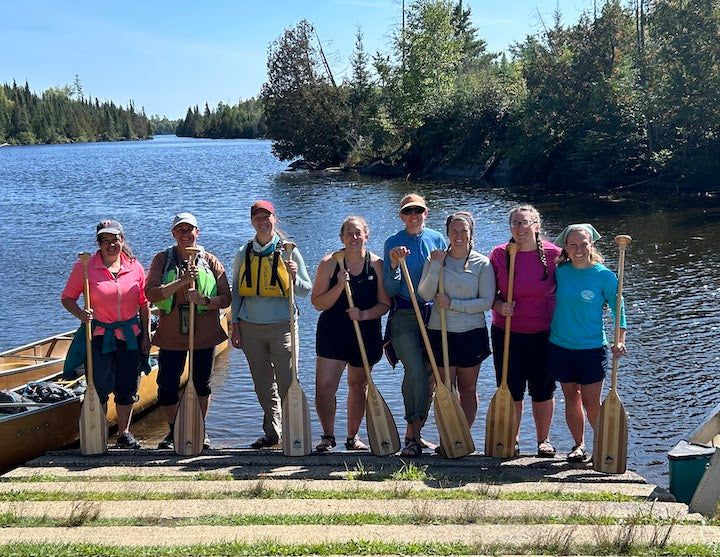
Our all-women’s Boundary Waters crew at the end of our trip (photo courtesy of a friendly stranger at the launch!)
I’m not sure why women’s canoe trip groups are so rare. There are wilderness camps that do a great job of bringing young girls and teens into canoe country. There are a couple of businesses that cater to women in the wilderness. But generally, an all-women’s group isn’t a common sight.
We’d love to help change that because the Boundary Waters is an excellent space for women to spend time with other women!
An All-Women’s Group is a Wonderful Way to Spend Time Together
I’m blessed to have an abundance of “adventure friends” in my life. So it’s not hard for me to gather a group of women eager to leave the city behind for a few days and head for the woods.
In this particular stage of life, I’m able to do this periodically because my husband and I are empty nesters. I’ve done the canoe tripping as a 20-something (camp counselor) and with our family when our kids were at home (mostly day trips, but one memorable 5-day trip with our kids and another family).
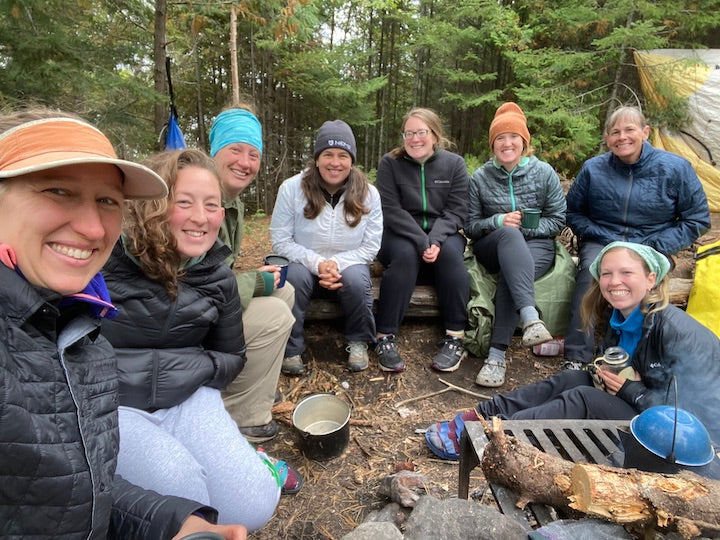
This kind of off-grid multi-day experience provides lots of opportunity for quality time with friends (photo courtesy of Brittany Dokter)
All of these types of trips are wonderful. An all-women’s trip is another wonderful way to get into the Boundary Waters. And with the right gear and skills, it’s more doable than many women may think.
I know we’re all different. Lots of women enjoy signing up for a trip without knowing another person in the group. I prefer to spend times like these with women who are already my friends, for a couple of reasons:
- There’s no wondering if the group dynamics will work. We simply invite those we know will do well together.
- I don’t have enough time with my friends as it is, so they’re the ones I prefer to be with for extended treks like this canoe trip. It’s a great excuse to spend time together.
For this particular trip, all of us had at least a little BWCAW experience, some with quite a bit. Our various strengths all contributed to keeping the burden off just one or two of us.
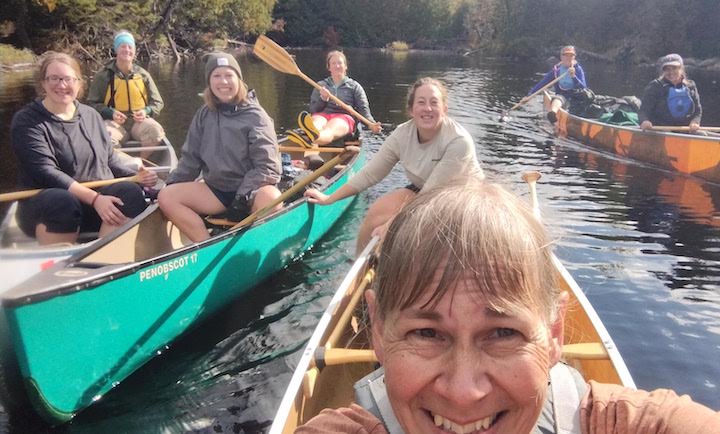
A canoe trip is a wonderful way for paddling friends to have time together without the distractions of day-to-day life
One of the reasons the BWCAW is so ideal for women to get together? No cell phone service! That eliminates so much of the distraction we fight every day. We wanted to have our phones along for photos and videos—me included—but kept them on airplane mode the whole time.
That alone meant we were constantly engaged with each other rather than with our screens. Alone time meant quietly sitting by the lake or napping in a hammock—not scrolling through Instagram.
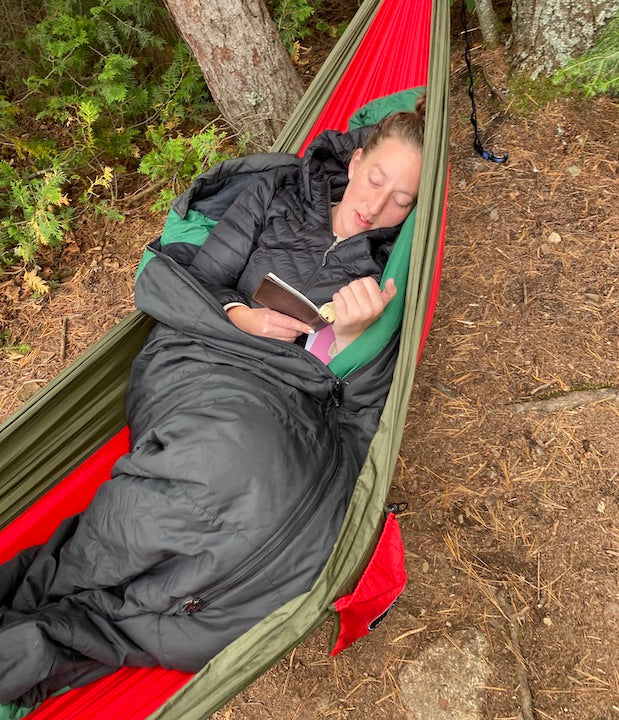
We thoroughly enjoyed being out of cell range!
Advantages of a Multi-Generational Women’s Canoe Trip
Partly because my kids are in their 20s and I know most of their friends, and partly because I’m active in a church with a healthy group of young adults—it’s normal for me to hang out with women of all ages. On this trip, our group hit every age decade from 20s to 50s.
When it comes to outdoor excursions like a canoe trip that involve paddling for hours and carrying heavy loads over challenging terrain, it’s so helpful for someone like me (58 years old at this writing) to be able to rely on younger, stronger women to haul the heaviest packs and canoes. 15 years ago, I could still portage our 65-pound Old Town Penobscot with relative ease. These days I much prefer one of the light Kevlar models!
And yet I bring a fair bit of experience when it comes to navigating, map reading, campsite choosing, trip planning and execution, and those types of soft skills also needed for a successful canoe trip. We all bring something, no matter our age.
Beyond that, I believe and have experienced that it’s very healthy emotionally for us to spend time with women of all ages, and not just our peers. These kinds of getaways are ideal environments for that.
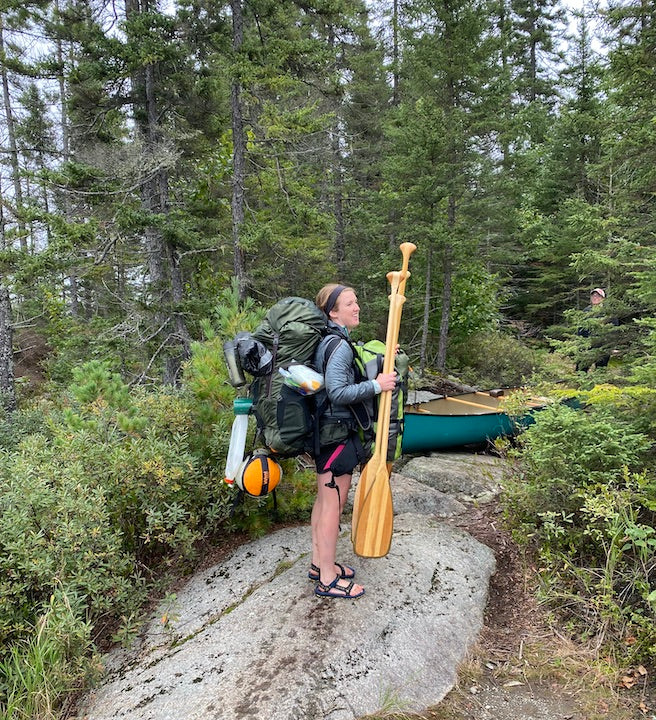
The younger and stronger women in our group were able to carry more than me more often! (photo courtesy of Brittany Dokter)
Challenges of a Women’s Canoe Group
There are two main challenges of an all-women’s canoe trip. The first we already talked about—having the physical strength to carry, lift and haul heavy stuff like canoes and packs.
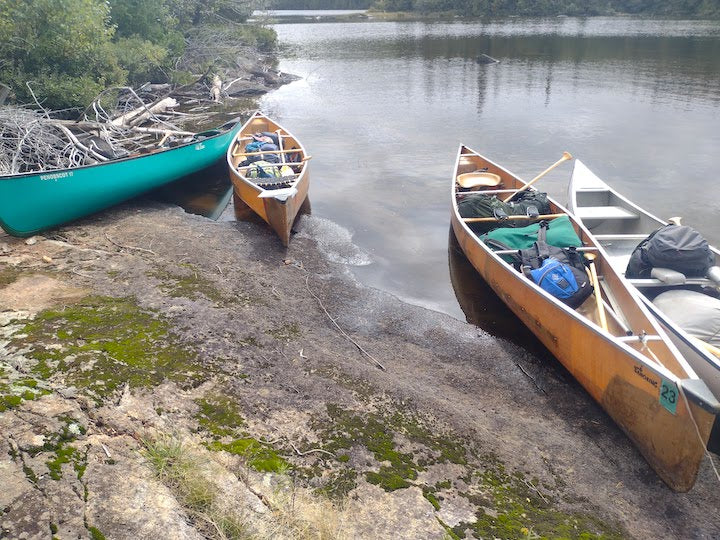
We knew we could bring two heavier canoes because several in our group had the strength to portage them
The other is for us women to gain the skills needed for a canoe trip. I know from experience that when I’ve gone with men—whether male counselors or my husband and grown sons—it’s so easy to let the guys do the heavy lifting, knot tying, tent setting up, food pack hanging, et cetera.
Women are perfectly capable of learning all these skills, too. Ones like:
- Paddling skills: We know basic canoe strokes and can head down each lake in the direction we want to go
- Packing know-how: We know what to bring and how to pack it
- How to tie a canoe on top of a vehicle
- Tent set-up, including ground tarps and rain flys.
- Fire building, wood gathering and sawing, hatchet skills; camp stove use
- How to hang the food packs properly to keep them out of reach of any local bears
- Knowing and using the right knots for the right situations
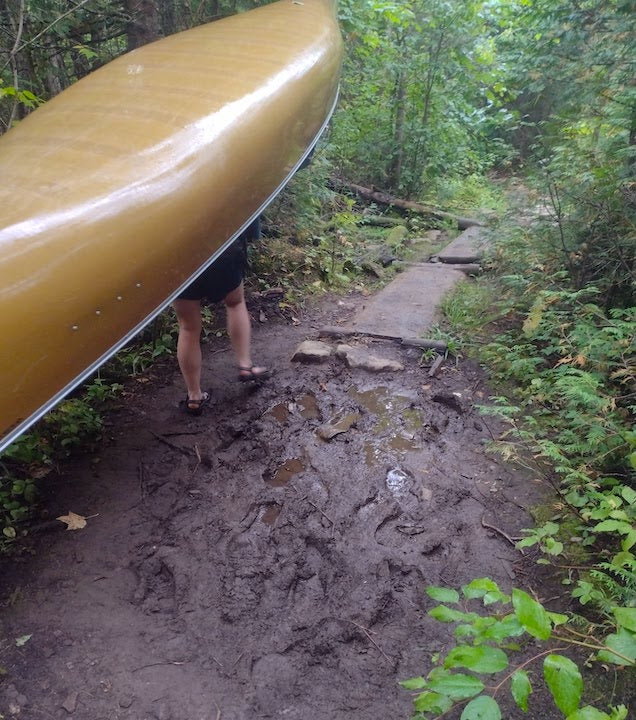
We had a lot of mud on this trip due to recent rain
None of these are hard to learn. It just takes intention.
Favorite Gear Items, Resources and Hacks from this Canoe Trip
We can learn something new from every canoe trip and from every person who comes along. I really enjoyed learning new hacks and ideas from others on this trip! Here are a few of them:
Luci Light: I got this idea from an interview I did with Ed Vater last year. A Luci Light is solar-powered, collapsible, ultra-lite and casts soft light for a group or for inside your tent. A single charge on a car hood the afternoon before our trip lasted the entire time. In fact, it was still fully charged when we got back.
Hot water bottles for bedtime: This idea came from the other mom. Her daughter had worked for two summers at a nearby wilderness camp. We boiled lake water just before bedtime and put it into our plastic water bottles to bring inside our sleeping bags with us. Since we had a couple nights in the 30s this was a wonderful hack! You want to use a thick-walled plastic bottle like Nalgene (I used my LifeStraw bottle).
Toe and hand warmers: I’m so glad I grabbed these at the last minute while packing. My wet feet got freezing cold on Day 2 during our 5-hour paddle and portage stint. After we got to camp I took off my wet stuff, put on dry wool socks and a toe warmer on the top and bottom of each foot, then my dry camp shoes. My feet warmed up within 10 minutes and stayed warm the rest of the day. I shared the hand warmers all around with those who hadn’t brought any.
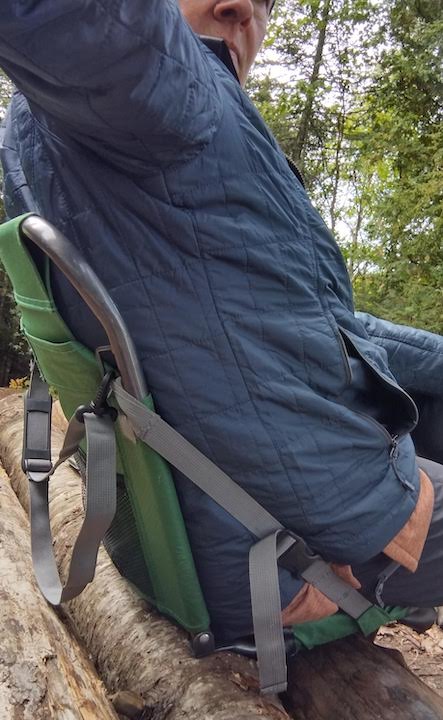
This stadium seat is amazing as a camp chair and can be strapped to a canoe seat
Stadium seat for canoe and camp: I have a $12 stadium seat I bought at Aldi a few years ago. It fits perfectly on a straight canoe seat, buckled beneath. And it’s the perfect lightweight camp chair while sitting around the fire, on a rock, on a log…even on the ground. It saved my back!
Silicon long-handled spoon: My husband and I were gifted these from my sister and bro-in-law. These are perfect for both cooking and eating. Very light, can handle heat and they’re easy to clean. A two-for-one tool.
Pulley system for hanging food packs: One of our group members brought her family’s pulley system along. What an easy way to hang heavy food packs! Our system used two pulleys and needed two trees. There are one-tree pulley systems available too. Here’s an example of a newer system.
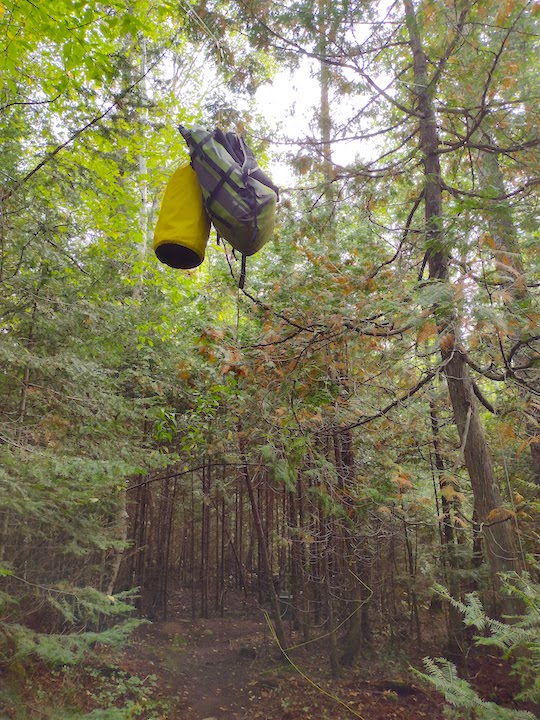
With a 2-tree pulley system, it’s easy to get the food packs at the right distance from the trees and the ground
Lightweight canoes: A game changer for women’s groups that include very young, small and older women (like me). Since I had only carried heavier canoes most of my life, it made the portages kinda fun rather than dreadful!
Easy, cheap fire starter: A couple of the easiest fire starters to bring on a canoe trip are also dirt cheap—1) dryer lint and 2) cotton balls rubbed with petroleum jelly. Either weighs just a few ounces and can be put in a small Ziplock. It had rained for many hours on Day 1 of our trip. So, on Day 2, it was wonderful to have reliable fire starters available when we reached our second campsite. One of the gals quickly got a warm fire going even though we only had wet wood to begin with.
Paddle Planner: I learned about Paddle Planner while interviewing these folks for other Bending Branches posts. This was the first trip I planned using this great resource, and wow, did it make things easy! I bought a month-long membership which enabled me to try out several different routes, check out portage and campsite reviews, and save routes for later reference. You still need a print map with you on the trip, but for planning—super!
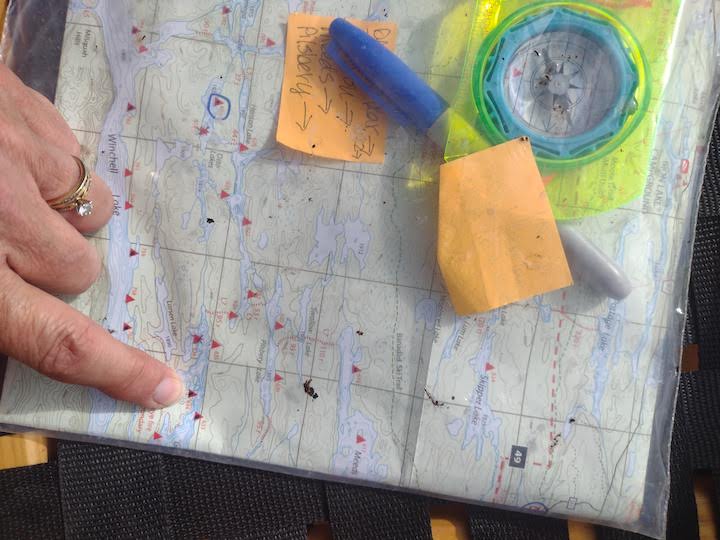
Paddle Planner made it easy to finalize a route to fit our group’s timeframe and ability
That Time of the Month
I was the only one in my group of eight women who was post-menopausal. One of the other members brought up the question of what to do if she got her period on the trip. My co-planner Emilie is a registered nurse and an experienced wilderness adventurer. Here was her answer:
“Period discharge is fine in the latrine but there really aren't many tampon brands that are actually biodegradable. I've always packed them out of wilderness areas. I recommend a menstrual cup or disc because they cut down on waste in general and can be left in quite a bit longer due to their increased capacity and decreased risk of TSS r/t resorption. They just need to be rinsed and re-inserted. I've been using them since 2014 and they have made traveling and camping so much easier!”
Here are a couple of articles for more information:
- Best Menstrual Cups and Discs (Emilie uses the Saalt brand)
- Complete Guide to Camping While On Your Period
Time to Plan YOUR Canoe Trip
If you’re not comfortable planning your own canoe trip and don’t have friends who are either, one option is to sign up with an outfitter like Women’s Wilderness Discovery. While on that trip, learn all you can from the guides and ask as many questions as necessary. Offer to help with everything.
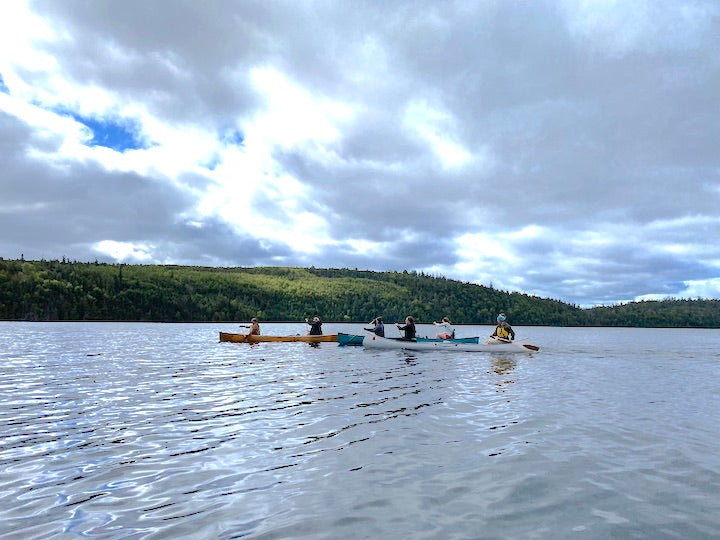
Our group paddling a Boundary Waters lake on Day 2 (photo courtesy of Brittany Dokter)
That will give you the confidence you need to start to venture out on your own. It may also give you new women friends who also love the canoe trip life.
It’s very empowering to take on this kind of physical challenge with other women. One of the younger gals, Sarah, said she felt stronger and stronger every day of our trip. The 70-pound Alumicraft that felt so heavy on Day 1 wasn’t a problem for her by Day 4.
These kinds of confidence boosters are a natural by-product of outdoor adventures like wilderness canoe trips. And that confidence readily overflows to other challenges we women all face in our daily lives.
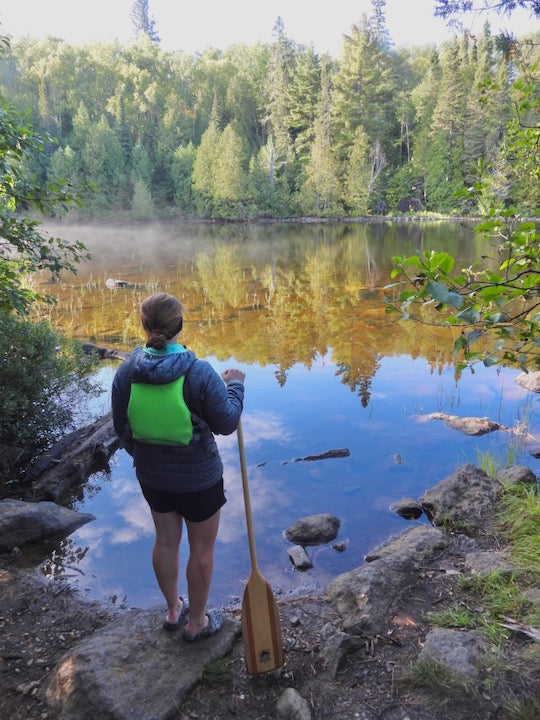
All photos by Sharon Brodin except where noted.
Do you have paddle questions our friendly Customer Service Team can help you with today? Contact them: 715-755-3405 • bbinfo@bendingbranches.com
More for you...










